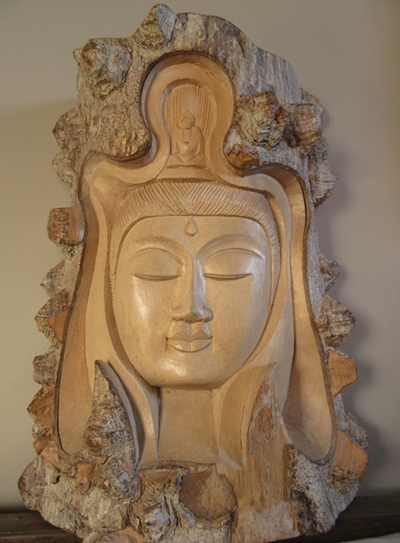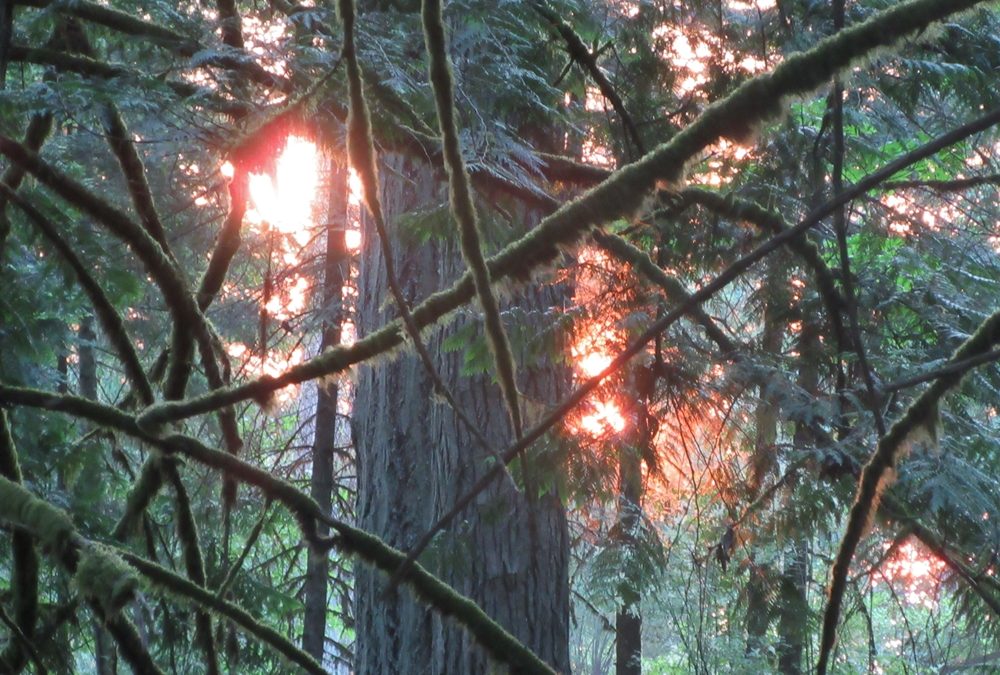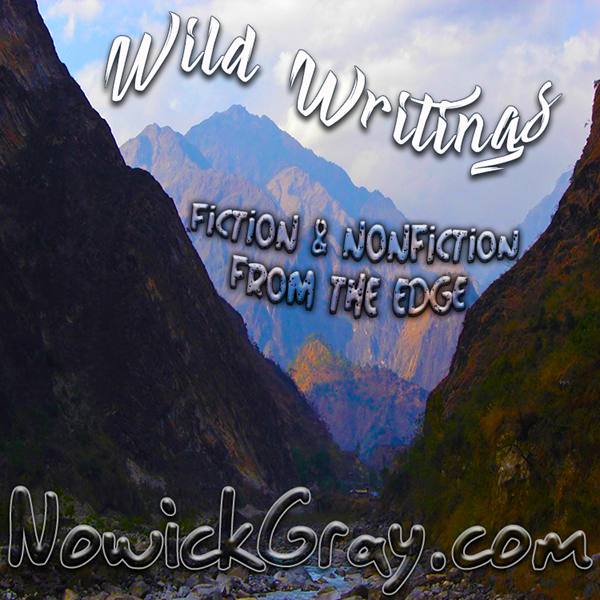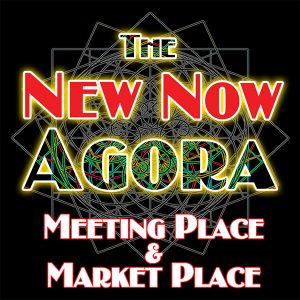No Present
by Nowick Gray
Is it important to cover the past, to entertain or explicate what happened and why?
Shall we instead embark on a speculative quest to predict or manage the future?
What is to be said about the all-encompassing present, complete in its own perfection, its paradox of simultaneous fullness and emptiness?
When asked to tell about a spiritual experience, the most apt example I can find is the present moment, in the developing. As the snowflake falls. As the fire crackles. My noble truths always begin and end here: in this moment of becoming that leads to the next present time, the next moment of becoming.
Here is the black hole to suck in all that might otherwise distract, the myriad irrelevancies of past and future. My perception of the present is of no static, boundless pool, but rather of an onrushing current of energy, called moving time, that I can respect best by riding. Whirlpool or rapids: the main thing is motion, eternal flux.
What else to say, then, but that?
All other truths point to it.
Love, devotion, surrender: these other noble truths are children of the parent truth, ways of giving form and consciousness and focus over to the here and moving now. Whatever the value of an ancient truth, I want to stress its dynamism, testing its resonance with the values of freedom, evolution and progress, growth and change. My way is to take the present moment as the primary truth, a truth told internally and made in the outer world each instant, now in the making.
I speak of the present time. Any yet, there really is no present. All is past and future, the one becoming the other. And we are not to freeze there in the newly become, but to keep on becoming.
We may speak of words as springboards. Let us then make a springboard of the present tense.
Words are useful illusions by which to manipulate and move ideas. Just as the present is a useful illusion of presence in time, of self-solidity in space.
Free will is a key ingredient, working forward by working back. We see the concreteness of what has been, by which to jump forward; or, by which to define what is coming.
This can be a curse, or a useful foundation. It is up to the judging free will to decide that. Not to let the pattern drag down, but to use it to build on: deer trail blazed by droppings.
As in any religion, this focus on an ever-moving now is the same as a one-god. A point of consciousness. Many spiritual time-thinkers worship the present, the concept of an all-present. They gather the past and the future into the now. That is a useful illusion. I would rather empty the present of the past and future, of self and world, of any meaning or time at all.
Why? Because to dwell in the present is to be stuck. To be more than vegetable is to move. That is our animal nature, to move freely in space. To be human is to move in time.
Isn’t this merely neat, another illusion? Let’s try it out.
There is no letting. We will try it out. There is no we. It will be tried:
To be human is to move in time. Following thought, forward; to new awareness. By building up awareness’s as they come: perceptions, idea-links, flashes of light: building up, or sensing and letting fly by.
There is no letting: they fly by.
To be human is to move in time. Is this mantra stuck? It’s part of a spiral. Human time is spiral, cyclical and ongoing. We are not part of the animal zoo, the caged pacing, if we choose not to be. If we choose to become other, to let novelty of experience enter freely at all times. Not to build another cage of thought or religion, even this one: because this, too, will be temporary, a season of ideas.
Let us move on.
There is no letting; we move. There is no we; it moves. There is no it; only moving. There is nothing to move, only movement. There is no time, only timing; no presence, only continuity, change, growth, spiraling life energy cascading into new space with new forms, new exchanges and interaction.
Words are only words. Yet they are useful, to move the mind forward. Not in themselves, but little thought vehicles, individual and linked like express trains on errands of consciousness, buzzing in a hive of understanding. Why is this valuable? Because otherwise it is easy to become mired in the dripping honey, the cells of wax.
I use the words to sing a prayer for the liberation of the dreams within us, so that they may fly back to the outer universe.
Let me see the me as us. Let us see the us as all. Let all see the all as nothing, and as all again.
There is no letting: we will undertake our own freedom of self-realization.
There is no self to be realized: but only to get out of the way for the universe to reveal its energy in a variety of forms: infinite variety, infinite beauty.

We rejoice in our ability to participate in this cosmic drama. We take pleasure in the awareness within mystery, of the paradox of the twin role: to “get out of the way” and “to participate.” In this balance is energy exchanged, and forms transformed.
No path here: just stillness. Why then go anywhere? Why indeed. We’ll sit awhile and let time do the passing through. We ride on it, waves of time carrying us, humans in the forest, through fields of stars.
Now we see in the extension of metaphor a jump to a higher scale of reference: yet still not mere abstraction. This is again the true fact of our existence, the reality of where we ride, where we move, body and mind, moment by sacred moment.
In this ride there is less freedom—no freedom at all as individuals. Only the freedom from all comparative distraction and illusion. Compared to this movement, this ride, all our pathfinding and roadbuilding is so much scribble, so much aimless fluff.
So we give up, for a while, that scurrying, and leave it to the ants, and instead hunker down for a ride of a lifetime, the gentle coasting through the vastness of space. Here time passes with such lengthy grace that it may seem as if it’s not passing at all. But again, we humans are well tuned to discern and appreciate the timing of this kind of passage, because we mark it in day and night, month and season and year. Not discernable in the small moment, quite; but in the higher scale of an hour, we can see that the earth has turned, and in a day that the berries have ripened, the leaves fallen, the snow melted, the geese returned.
In the vastness of space we find ourselves, in motion so grand and graceful that all lesser movement loses significance. We might say such a condition is boring. But if we’ve taken the trouble to get there—by arduous tunneling and wading through tangle of brush, by breaking free of both prefabricated routes and the obstructions along the way—we can find the natural pace of progress, in directions we choose and at a pace we can enjoy. We can find ourselves, either with a view of the stars or a view of the trees, or both, if we stay up day and night, and in this place we can finally rest awhile, take our breath, and smile.

Now. The thing is to get in touch with the moving now.
How to accomplish this? For the exercise I take the actual, conventional “present” as my starting point. The obvious impulse is to try to expand the experienced definition of present, so as to include an increasing range of time forward and back. In doing so I notice that the pulsing frame of “the present” can also shrink, or begin from an infinitely small point. What does this shrinking frame leave behind, outside its arbitrary boundaries? All vagueness and unreality? Perhaps… but as the fresh picture develops it takes on more and more the colors of present sensation, so that what is left to cover the tracks of the disappearing present moment is an infinitely greater everything-else of the rest of time: a new, boundaryless presence.
Back to the present. Conventional time, normal consciousness. The habitual, practical time frame of, say, the hunter or farmer, cook or parent. Some use of memory, some planning, dream and fantasy, but mostly awareness in a more or less momentary, moving present. That awareness is purified, the spiritual practitioners say, by limiting the idle or anxious diversion into past or future scenarios, by concentration on live breathing. This psychophysical short-circuiting of past/future diversion accomplishes what the shrinking-present exercise accomplishes: perhaps even quicker, more naturally and directly. By using past and future as springboards, consciousness is habituated to those normally distant stations as alternate home-bases—and, ultimately, as simultaneously valid aspects of a now-greater (we may as well say all-encompassing) present.
To begin, then: step by step. The beginning is the hardest, because the visual sense, so dominant, is so static, so seeming frozen—or at least firmly welded to a present that’s moving (or ongoing, or continuing). The quality of movement or continuity offers a clue to the process. The present now is different than the present a moment ago—even if the visual field (and the rest of the sensory palate) remains essentially unchanged. But wait: how then can I state the difference? By mere assumption?
The narrow focus remains. The present is fleeting, ephemeral, transitory, evanescent: in fact, does it exist at all? My attempt to expand it has failed miserably. I cannot pin it down, stretch it or—and many words later, I’m almost ashamed to admit—even define it adequately. Maybe that’s the trouble—I haven’t even yet defined my basic term. What is this fanciful realm I and everyone calls “the present”?
If, as I suspect from my initial headlong rush into shrinking that thing I hadn’t yet defined, there is very little reality at all to the present, then the whole affair becomes simpler and more understandable—if also then grander and more ineffable. To shrink a shaky little nonentity like the present seems a fitting thing to do. If it cannot be pinned down or manipulated, or perceived or even clearly conceived, what right does it have to exist at all?
For convenience’s sake, perhaps: a frame, a vehicular aura, for what is perceivable. Not, then, a thing in itself, but merely an aspect or qualifying term relative to subjective human experience. Isn’t that a useful enough function in the world? Why this bitter, demeaning attitude of rejection and diminishment?
All right, fair enough. I pay homage to convention. There is such a thing as present time—however subjectively defined. The dictionary calls it a moment or period of time situated between past and future—what a cop out! But what else could they say? Still, I aim to redeem the present by extinguishing it.
If I cannot write the present off by authorial fiat (the dictionary after all holds rule over the use of language), then the experimental approach becomes essential. To write a living, present definition is my task. Once more I proceed. To boil down the essence: A present, now, is… gone.
There is, in all candor, nothing there. Nothing even moving with me into the so-called future. Pure consciousness (if I may be so bold) has nothing to do with paltry terms such as present, past, or future. Human consciousness, cosmic consciousness or being, has no real use for these terms as a way of understanding anything about deeper reality. They are practical divisions only, for classifying our experiences and affairs. As for references to such mysteries as time itself or to the fundamental ground of being, these terms are out of their league.
I can say, with a glib twist of logic, that in place of a shrinking, narrow-focused, momentary present comes an all-encompassing present, a newer, better version of time that gives a total, comprehensive and permanent focus never needing adjustment or updating, a present utterly transcendent of personal sensation or spatial perspective. Have I then found God, or Truth, or unlocked the mystery of the universe?
If one wants to say so. It’s all, after all, a matter of the convention of what words we want to use when we’re conversing like this. A tiny present or a total one, or an habitual one in between, it’s all a matter of what we want to conceive of, how we want to think, what we want to fill our consciousness with. It has been refreshing, I think, to shuffle the usual fences set up around this sacred cow, the present—and for a while to let them down altogether while the beast roams free under the starlight.
—
image credits:
(feature) trees: Nowick Gray
meditation: Susan Ferguson
goddess: Nowick Gray
—
Nowick Graywrites from Salt Spring Island, BC. His books explore the borders of nature and civilization, imagination and reality, fiction and nonfiction. Connect at NowickGray.comto read more, and sign up for the “Wild Writings”email newsletter for updates and free offers. A regular contributor to The New Agora, Nowick chats with Lorenzo in this video interview about his life journey to manifest truth and freedom.



 nowickgray.com
nowickgray.com








